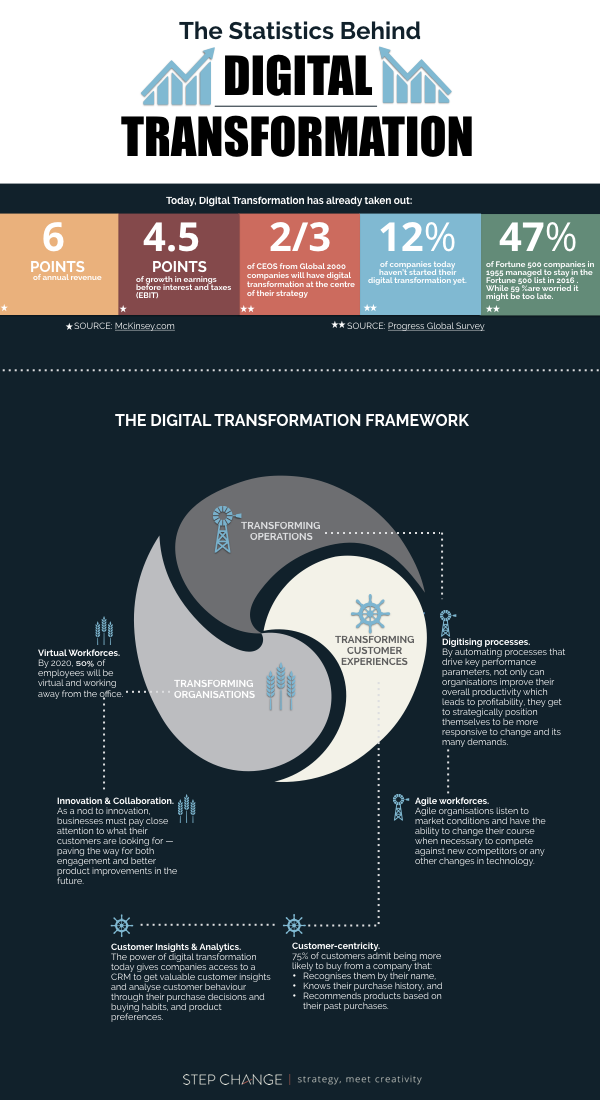Digital transformation — you may have heard this term in a recent digital conference you’ve attended, or you may be even assigned to lead one. And you’re not the only one, because right now, it is a big focus in growing organisations.
Digitisation has only begun to transform many industries, data from McKinsey research reveals. While its impact in the economic performance of companies is compelling, it is far from complete.
According to EBIT, on average, digital transformation has wiped out 6 points of annual revenue and 4.5 points of growth in earnings before interest and taxes. In addition, 49 percent of companies today focus their investments and digital strategies on distribution channels and marketing.

Image from atlasdigitalpartners
When doing a quick comparison of the 1955 Fortune 500 companies with the 2016 Fortune 500, only 60 companies appear in both lists. In other words, only 12% managed to stay in the list and successfully made it through digital transformation. (See Exhibit 1 above)
Digital Transformation Defined
Put simply, Digital transformation is the use of technology to improve an organisation’s performance. Transformation can be done throughout the entire organisation or in stages. Many organisations choose to just update what is needed to thrive in a digital world.
No matter what path your organisation takes, it is important to note that digital transformation focuses on three key areas: your operations, your business model, and the customer experience.
It was highlighted in Progress' State of Digital Business Report that 47% of companies today have not started their digital transformation yet. From this same report, 59% of companies are worried that it might already be too late for them.
Check out more of these statistics in our Digital Transformation Framework infographic below.

Transforming Business Operations
Many companies today spend at most 75% of their IT budget on maintaining their internal system alone. By now, these same companies need to start acknowledging the need to look into segments in their day-to-day operation and processes that can be digitised for better efficiency and performance management that can boost their bottom line.
Digitising Processes
The first step towards digital transformation is acknowledging that there is a divide in the first place that may prevent an organisation from becoming fully performance-led.
By automating processes that drive key performance parameters, not only can organisations improve their overall productivity, which leads to profitability, they also get to strategically position themselves to be more responsive to change and its many demands.
The use of analytics helps you track your product performance to give you more room for improvements. Additionally, migrating to the cloud can help you save on your bottom line by getting rid of expensive software costs and maintaining internal systems.
Shifting your data infrastructure to the cloud also gives you an added layer of security and reliability through the third-party host’s own set of safety best practices that complement your own data security measures.
Agile Workforces
We see digital transformation in more agile organisations who are quick to notice common operational bottlenecks and take actionable steps to address what is not working before it delays projects even further.
Agile organisations lead the pack in listening to market conditions and having the ability to change their course when necessary to compete against new competitors or any other changes in technology.
Transforming the Customer Experience
Customer Insights & Analytics
Companies today are lucky to have the means to get to know their customers better. The power of digital transformation today gives companies access to a CRM to get valuable customer insights and analyse customer behaviour through their purchase decisions, buying habits, and product preferences. We often see CRMs today collect the customer’s digital footprints — giving organisations a better understanding of what their customers want and are looking for.
Customer-Centricity
The move towards customer-centricity should not only be in terms of strategy but through the use of organisational systems today that empowers organisations to take that next step towards understanding what their customers want. This gives them critical information so they can start offering products that their customers actually need.
“Customer experience innovation”, CX transformation expert Lynn Hunsaker writes in a blog article, “creates mutual value for anyone in the holistic definition of customer, regarding any aspect of their experience with a solution, with a focus on the customer’s jobs-to-be-done.”
In her 4-year study, Hunsaker also found that “systemic customer experience improvement and innovation were under-used building-blocks in the cause-and-effect system of customer experience optimization”.
She also adds that company-wide improvement and innovation of customer experience is the middleware for sustainable business results.
Companies that achieve digital transformation create highly engaged customers.
And these customers are
- 6x more likely to try a new product or service from their preferred brand
- 4x more likely to have referred your brand to their friends, family, and connections
- 2x more likely to make a purchase with their preferred brand, even when a competitor has a better product or price
It is also worth noting that customers who are highly engaged have been found to buy 90% more frequently, spend 60% more per purchase, and have 3x the annual value (compared to the average customer).
Accenture has found that 75% of customers admit being more likely to buy from a company that:
- Recognises them by their name
- Are familiar with their purchase history
- Suggests products based on their previous purchases
Transforming the Organisation
Now more than ever, organisations can become a key player in the market by creating an environment that adds value both to their customers, their employees, and their partners.
Innovation & Collaboration
As a nod to innovation, businesses must pay close attention to what their customers are looking for — paving the way for both engagement and better product improvements in the future. Online forums are a great way to take customer opinions into consideration as they may hold the key to the future.
According to new research from Altimeter Group, CMOs are nearly twice as likely as CIOs to jumpstart digital transformation within their organisations.
Innovation acceleration, IT infrastructure modernisation, and operational agility improvement — these are the top transformative initiatives and they fall under IT’s jurisdiction, but there’s a division between the trends propelling change and the people who lead the initiative.
Virtual Workforces
It is staggering to note that by 2020, 50% of employees will be virtual and working away from the office. This year, we’re seeing more always-connected laptops that rely on mobile networking technology to stay connected. With an increase in 4G/LTE cells and public Wi-FI access points placing greater demand on mobile networks, a need to deploy 5G networks is expected.

We see more virtual workforces in the future who are quick to adapt to changes in the market for the benefit of both their employees and the entire company as a whole.
To win, organisations need to build a culture of change that is adaptive to the new rhythm of disruption by which the industry is operating today. (Image credits to: Alex Kotliarskyi)
But through it all, culture plays a pivotal role in the success of digital transformation efforts in organisations. The adoption of new technologies is greatly reliant on culture. To win, organisations need to embed a culture of change that is adaptive to the new rhythm of disruption by which the industry is operating today.
The Digital Transformation Takeaway
With a highly volatile business environment, the only way companies can achieve sustainability is by finding a way to always re-invent themselves to adapt to changing trends. Nothing ever stays the same.
Today’s top industry game changers may know how to work with what they have, but they exceed all others in trying out new technologies that could shape the future for everyone else.
It’s also worth noting that the board of directors play a crucial role in a company’s digital transformation initiatives. That’s why it’s important that they appoint a member with operational capabilities, a digital disruptor, who is able to lead the entire organisation to transformation.
Looking at these industry statistics only goes to show that digital transformation today is crucial to survival. Ignoring it altogether is a mistake that may be difficult to recover from when everyone in your industry is already miles ahead.










![#KatieTalks to Step Change’s Robert Steers [PODCAST]](https://blog.hellostepchange.com/hubfs/BLOG/Posts/5-Connection/katie-talks-robert-steers.001.jpeg)






